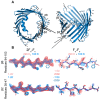Insights into VDAC Gating: Room-Temperature X-ray Crystal Structure of mVDAC-1
- PMID: 39456136
- PMCID: PMC11505624
- DOI: 10.3390/biom14101203
Insights into VDAC Gating: Room-Temperature X-ray Crystal Structure of mVDAC-1
Abstract
The voltage-dependent anion channel (VDAC) is a crucial mitochondrial protein that facilitates ion and metabolite exchange between mitochondria and the cytosol. Initially characterized over three decades ago, the structure of VDAC-1 was resolved in 2008, revealing a novel β-barrel protein architecture. This study presents the first room-temperature crystal structure of mouse VDAC-1 (mVDAC-1), which is a significant step toward understanding the channel's gating mechanism. The new structure, obtained at a 3.3 Å resolution, demonstrates notable differences from the previously determined cryogenic structure, particularly in the loop regions, which may be critical for the transition between the 'open' and 'closed' states of VDAC-1. Comparative analysis of the root-mean-square deviation (R.M.S.D.) and B-factors between the cryogenic and room-temperature structures suggests that these conformational differences, although subtle, are important for VDAC's functional transitions. The application of electric field-stimulated X-ray crystallography (EF-X) is proposed as a future direction to resolve the 'closed' state of VDAC-1 by inducing voltage-driven conformational changes in order to elucidate the dynamic gating mechanism of VDAC-1. Our findings have profound implications for understanding the molecular basis of VDAC's role in mitochondrial function and its regulation under physiological conditions.
Keywords: electric field-stimulated X-ray crystallography (EF-X); mitochondrial biology; room-temperature crystallography; voltage-dependent anion channel (VDAC).
Conflict of interest statement
The authors declare no conflict of interest.
Figures







References
MeSH terms
Substances
Grants and funding
LinkOut - more resources
Full Text Sources

